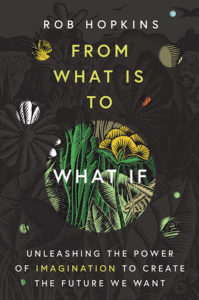From What Is to What If: Unleashing the Power of Imagination to Create the Future We Want
Reviewed by Ruah Swennerfelt
January 1, 2020
 By Rob Hopkins. Chelsea Green Publishing, 2019. 240 pages. $24.95/hardcover or eBook.
By Rob Hopkins. Chelsea Green Publishing, 2019. 240 pages. $24.95/hardcover or eBook.
I’ve been involved with the Transition Movement since about 2008 and had the opportunity to meet and interview Rob Hopkins, cofounder of the movement and author of this book (his sixth), in 2011 at the fifth Transition Network international conference in Liverpool, England. I was initially drawn to the movement because of its focus on working locally; inviting everyone to the table; climate change and climate justice; and a deep caring for Earth, soil, water, air, and all that lives.
This book is not a how-to book but an invitation to break out of our feeling stuck by “what is” to unleash our imaginations by asking “what if?” I was inspired by a story in the book of some young people who, after attending one of Hopkins’s workshops, marched to a climate strike event carrying a banner with the large words “What If?” They then passed out cards asking people to complete a sentence that began with those words. So recently, when I had agreed to attend back-to-back, daylong conferences, I passed out stamped self-addressed cards with big red letters of “What if?” on one side, and asked people to share their visions. They are beginning to trickle back to me, and they are filled with joyful, playful, and poignant words that are full of hope. One person asked, “What if everyone in our communities felt safe, welcomed, valued, respected, included? What if our community centers were beautiful, vibrant, safe hubs for civic engagement and discourse?”
Hopkins writes, “We need to master the art, it seems to me, of asking questions which address the gravity of our situation yet which also create longing, which evoke a deep and rich sense of the wonders we can still create, rather than shutting it down or putting it into a deep sleep of complacency.” And he shares stories from all over the globe of the transformations occurring in communities where the residents imagined what could be, without first worrying about what might prevent them from acting.
The chapters are as playful as the question, like “What If We Took Play Seriously?” or “What If We Followed Nature’s Lead?” or “What If We Became Better Storytellers?” Hopkins says he wants to “put the imagination back at the heart of how we think about the future, and about what kind of future we might create, the future that is still possible to create.” He includes stories about organizations that use art as therapy or some that help folks reclaim their attention. The stories throughout the book inspired me to think in a “what if?” mode and dream of what a wonderful future we can all bring into reality.
Hopkins challenges and inspires readers: “What if we revived our collective imagination, and asked ‘What If’ in great abundance—starting now?”



Comments on Friendsjournal.org may be used in the Forum of the print magazine and may be edited for length and clarity.